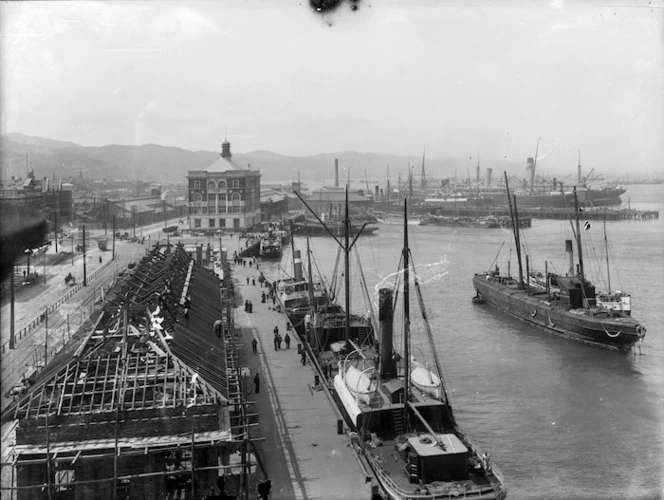Build Date
1900
Boat Builder
Robert Logan
Length
101.2 Feet
Beam
19 Feet
Building The Countess
On the 23rd April 1900 the Wellington Ferry Company Ltd., announced it was building a new ferry for the Wellington Harbour and only a few months later The Countess was launched in December 1900. Robert Logan of Auckland was commissioned to undertake the large build using kauri. After her launch, The Countess was towed to Thames to have her 168ihp steam engine installed by A and G Price Ltd. She was then towed back to Auckland for her boiler to be installed and again to Thames to complete the engineering. Even then her build was not complete as she was berthed at Queen Street Wharf for her passenger accommodations to be built. It was only after she had her compass adjusted and ran sea trials where she reached speeds of 11 knots on 8th January 1901 that she was deemed complete. The next day she left Auckland for Wellington with Captain Butt as skipper.
It took them 5 days to get to wellington in which they hit rough weather and lost a propeller blade causing them to slow down. But they made it to Wellington, and she was moored at Days Bay so the propeller could be fixed and on the 22nd January 1901 she made her first commercial trip from Days Bay to Lambton Quay with Captain Reid at the helm. The Countess would be used for the ferry service around the Miramar peninsula taking passengers to and from the city but also to tow coal hulks.

Draught
8.7 Feet
Gross Tonnage
189.16 tons

The Countess Becomes A Fishing Boat
Only seven years after her build The Countess was deemed surplus to requirements as public transport improved and the passenger numbers dropped. So, she was offered for sale and the Hawkes Bay Fisheries Company of Napier purchased her. Specifically, T.P. Vautier and C.A. Vautier were her registered owners from 1908-9 and then until 1915 she is registered to the Countess Trawling Company Ltd.
Their plan was to convert her to a trawler. To do this they commissioned S. Wood Ltd., to remove the top deck, add a 24ft by 10ft steel deckhouse for the engine and boiler, add a trawl winch with 600 fathoms of 2 ½ inch wire brought over from Britain, build an 8 tons fish hold and accommodation for ten crew. This cost the large sum of 3000 pounds. With the work complete The Countess went through some more sea trials, adjusted her compass and fixed a problem with her steering gear. She then left for Napier on the 23 March 1909.
Captain Samuel Gampton was appointed The Countess’s master. With the lower east coast of the North Island experiencing fishing shortages they hoped The Countess would find new fishing grounds. She did well in her first year and set a new trawling record landing 5,000 bundles of fish. Her normal catching rate was between 3,000 and 4,000 bundles of fish from her twice a week fishing trips targeting snapper and terakihi. At this time The Countess and Nora Niven were the largest trawlers to call Napier home.

Sanfords Ltd. Buys The Countess
In 1910 the east coast fishing grounds again were yielding less fish. The Countess had to change locations, fishing the Cook strait, Tasman and Golden Bay instead.
In 1915 Sanford Ltd., were changing their business model from buying fish from small owner operated boats to getting their own larger boats. They had intended on buying boats from the UK but the war made that difficult, so they looked closer to home and purchased three boats. These boats were The Countess, Muriel and Baroona which needed converting to fishing.
The purchase of The Countess and Muriel impacted the way trawling was undertaken in NZ as they used a technique called Otter Trawling which would become commonplace. The Countess also brought her captain Axel Nilsson and mate James Holt with her.
In 1922 The Countess with James Holt at the helm became the first Auckland based trawler to cross the Manukau bar to unload at Onehunga. In 1923 they converted to Danish seining which she would use to complete good catches but by the late 1920s Sanford Ltd., decided to stop fishing with The Countess and laid her up at Shoal Bay, Auckland whilst she was for sale. They had decided she was surplus to requirements as they were using new technology and they now preferred steel boats with large holds. In 1935 after several failed attempts to sell The Countess she was converted to a coal hulk.
Believed to have sunk at her mooring at Shoal Bay in October 1933. The scows Moa and Waikonini were used to raise her but is unknown what happened after this.
References
To research The Countess we used the book Nets, Lines and Pots: a History of New Zealand Fishing Vessels Vol 3.
Related Posts
Miss Akaroa – Took George Brassell 12 months to build in his backyard. Brassell charter boat and later a pleasure boat
Hautapu – 1942 NZ Navy minesweeper coming fishing boat.
Karaka – Built for the Wellington Harbour Ferries Ltd., in 1910 Karaka would go to a 71 year long oyster fishing career.
Manuka – 135.9ft NZ Navy minesweeper built in 1941. After the war she became a fishing boat.
